
Before the popularization of multi-kilowatt lasers, laser cutting was mainly superior to plasma cutting for thin sheets below 10 mm. However, in the 30 to 50 mm thickness range, plasma cutting had a clear advantage in terms of speed and laser cutting could not compete.
With the emergence of multi-kilowatt lasers and now the widespread adoption of 60kW lasers, laser cutting is expanding into the realm of medium and thick sheet metal cutting. During this period, the plasma cutting market has seen a dramatic decline and is gradually being replaced in certain application scenarios.
The rapid increase in laser cutting market share can be attributed to two main factors: the maturation of high-power fiber laser technology and the rapid development of manufacturing industries such as steel construction, shipbuilding, aerospace and nuclear energy, which have an urgent demand for efficient and high-quality cutting of thick plates.
In recent years, enthusiasm for multi-kilowatt lasers has continued unabated, rapidly sweeping the laser industry, although not without its skeptics, particularly with regard to the recently introduced 60 kW laser cutting machines, which have been the subject of lots of debate.
Surprisingly, in less than six months, demand for 60 kW laser cutting machines outstripped supply. The steel construction industry has repeatedly repurchased ultra-high-power laser cutters to replace plasma cutting, which seems to contradict the skepticism. The importance of ultra-high power lasers for metal cutting processes is far from common when considering the replacement of traditional processes and application scenarios.
Replacing Plasma Cutting with Laser
The replacement of plasma cutting by laser technology is accelerating.
Even before the widespread adoption of laser cutting, plasma cutting was the most mature process in metallurgy. It used the heat from a high-temperature plasma arc to locally melt the metal in the cut, and the momentum of the high-speed plasma was used to eject the molten metal, forming a cut. Plasma cutting was known for its reasonable quality and cost. At that time, plasma cutting was still widely used in the thin and medium plate segments due to its fast cutting speed and smooth cutting.
However, with the emergence of laser cutting, it began to impact plasma cutting to some extent. In the thin plate cutting sector, kilowatt-level fiber lasers have an absolute advantage over plasma cutting in terms of quality and efficiency. Their high precision, narrow cutting, minimum heat affected zone, burr-free edges and high cutting speed have made them the preferred choice in this field. In contrast, the disadvantages of plasma cutting have become increasingly apparent.
To counteract the impact of laser cutting, equipment manufacturers have developed more refined plasma cutting machines to solve problems such as rough cutting surfaces and poor perpendicularity. By reducing the size of the nozzle opening, a highly compressed arc is created, significantly increasing current density for greater cutting precision and surface finish. However, plasma cutting in the domain of thin sheets cannot yet compete with laser cutting in terms of processing efficiency, precision and environmental friendliness.
As the thickness of processed materials increased, kilowatt-level laser cutting also faced challenges. In the segment of medium and thick sheets of 30-50 mm, the cutting speed of laser cutting was significantly lower than that of precision plasma cutting machines, which maintained its position in this domain.
In 2020, the advent of ten-kilowatt laser cutting technology injected new life into metal processing, aiding the transformation and modernization of traditional industries. At that time, laser cutting entered the ten kilowatt era and started a second round of challenges against plasma, fiercely contesting the vast plasma cutting market.

For carbon steel/stainless steel up to 20 mm thick, a 20 kW laser cutting system outperforms a 300 A plasma cutter. However, the initial purchase cost of laser cutting is significantly higher than than plasma cutting, leaving users hesitant between the two options. It was still too early to discuss a complete replacement.
In 2022, the widespread adoption of 30 kW laser technology has really started to shake up plasma cutting's dominant position, especially impacting the medium to thick sheet metal market.

In 2023, the rapid advancement of domestic ultra-high-power fiber laser technology led to the emergence of 60kW lasers, which truly broke through the limitations of cutting thickness and once again challenged plasma cutting.

In terms of cutting efficiency and quality, 60 kW laser cutting now has the ability to completely replace plasma cutting. Currently, laser cutting and plasma cutting are equivalent in terms of overall economic benefits, with each dominating half of the market. Ultra-high-power laser cutting reveals an extremely broad application perspective.
Fiber Laser Cutting Versus Plasma Cutting
In recent years, demand for laser cutting applications has shown signs of rapid growth due to upgrading demand from downstream industries and the decline in the cost of high-power lasers.
However, plasma cutting can be prone to producing significant deformations when cutting sheet metal below 6mm and has high cutting precision requirements.
On the other hand, laser cutting has clear process advantages, especially for materials with high melting points, heat-resistant alloys, super-hard alloys, semiconductor materials, non-metallic materials and composite materials.
1. Comparison between fiber laser cutting and plasma cutting
| fiber laser cutting | plasma cutting | |
| Principle | A high-power density laser beam is employed to scan the surface of the material, rapidly heating it to temperatures ranging from thousands to tens of thousands of degrees Celsius.
This causes the material to melt or vaporize, and the melted or vaporized material is then removed from the crack with a high-pressure gas. |
With oxygen or nitrogen as the working gas, a high-temperature, high-speed plasma arc serves as the heat source, locally melting the metal being cut.
The molten metal is then removed by a high-velocity airflow, forming a narrow slit. |
| Material | Metallic materials, special metallic materials and non-metallic materials | Carbon steel, stainless steel, aluminum, copper, cast iron and other metal materials |
| Cutting thickness | Medium thickness plate | Medium thin plate |
| Cutting precision | Finish machining (within 0.2mm) | Rough machining (within 1mm) |
| Slit width | Very small (0.2 ~ 0.3mm) | Small |
| Heat affected zone | Very small (width 0.1 mm) | Small |
| Plate deformation | Tiny | Small |
When replacing some punching functions with laser cutting, it may be necessary to purchase a press brake to complete the subsequent bending process.
This is a common consideration for customers when purchasing a laser cutting machine.
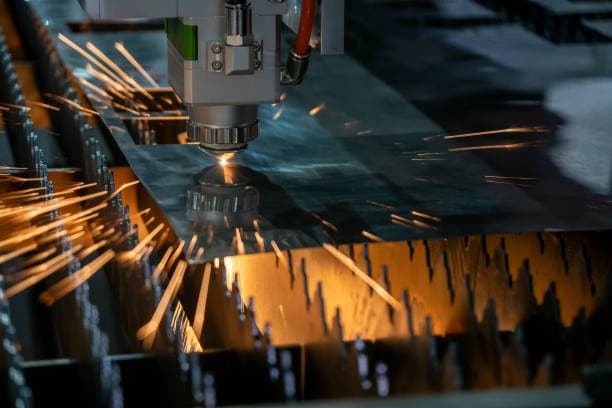
2. Advantages of fiber laser cutting over plasma cutting
| Item | fiber laser cutting | plasma cutting | Advantages of Fiber Laser |
| Positioning Accuracy | 0.14mm | 0.4mm | High precision |
| Section perpendicularity | 0.2mm (40mm) | 5mm (40mm) | No finishing required |
| Slit width | 0.2-1.5mm | 2-5mm | Save materials |
| Reserved edge and common edge | 3-4mm | 10mm | Save materials |
| Heat affected zone | 0.1-0.4mm | 0.5-2.0mm | Small deformation |
| Section quality | Excellent, less scum hanging | Normal | No grinding required |
| Cutting speed (within 20mm) | Very fast | Normal | High production efficiency |
| Cut a small hole | Diameter depth ratio: 10-20% | Can't cut the hole | Save the drill and transfer |
| Chamfering | Chamfering | Generally not | Saving chamfering machine |
| Desktop | To clean | Smoke filled the house | Health and environmental protection |
3. High power laser cutting over plasma cutting
The growing popularity of high-power lasers has allowed laser cutting equipment to surpass the thickness limit.
Previously, the sales volume of high-power lasers was very low, and the application of laser cutting was restricted by thickness for a long time.
Traditionally, flame cutting was believed to have the widest range of sheet thicknesses, being suitable for processing thick and extra-thick sheets with low precision requirements, and having obvious speed advantages for sheets thicker than 50 mm.
Plasma cutting, on the other hand, has an obvious speed advantage in the 30-50mm range, but is not suitable for extremely thin sheets (<2mm).
On the other hand, laser cutting, which mainly uses kilowatt-level lasers, has obvious advantages in speed and accuracy for sheets below 10 mm.
In recent years, with the increasing popularity of high-power lasers, laser cutting equipment has slowly infiltrated the medium-thickness plate cutting market.
The limit cutting thickness and ideal cutting thickness for a 20 kW laser cutting machine (mm) are included.

The increase in power results in an increase in the cutting thickness and equipment efficiency.
According to statistics, the 20 kW laser cutting machine achieved an ideal cutting thickness of 50 mm for carbon steel and 40 mm for stainless steel.
Steel sheets are generally categorized as thin sheets (<4mm), medium sheets (4-20mm), thick sheets (20-60mm) and extra thick sheets (>60mm) based on their thickness.
With a cutting power of 10,000 watts, the laser cutting equipment can now cut medium plates and most thick plates, expanding its applications into the medium plate field.
Furthermore, high-power lasers also result in higher cutting efficiency.
For example, the cutting efficiency of a 30,000-watt laser cutting machine on a 50mm mild steel plate can be increased by 88% compared to a 20,000-watt machine.
Advantages of high power fiber laser cutting over plasma cutting
| Thickness | 15kW (m/min) |
20kW (m/min) |
30kW (m/min) |
Efficiency improvement (30 kW over 20 kW) |
| 8 | 11 | 15 | 22 | 47% |
| 10 | 8 | 11 | 17 | 55% |
| 14 | 5 | 6 | 7.5 | 25% |
| 20 | 1.5 | 2.5 | 4.5 | 80% |
| 30 | 0.9 | 1.2 | 1.6 | 33% |
| 40 | 0.35 | 0.6 | 1 | 67% |
| 50 | 0.2 | 0.4 | 0.75 | 88% |

4. Fiber Laser Cutting Cost vs Plasma Cutting Cost
In the field of cutting medium thickness sheets, the cost of laser cutting is significantly lower than that of plasma cutting.
Plasma cutting is one of the main methods used in the area of thick plates, however, the cost of laser cutting is lower for two reasons:
- Laser cutting equipment and personnel requirements are minimal, reducing overall fixed costs.
- Laser cutting is more efficient in terms of productivity.
For example, when cutting a 30mm thick carbon steel plate, the operating cost per meter for 12kW laser cutting, 20kW laser cutting and 300A plasma cutting is 3.05 yuan/meter, 1 .32 yuan/meter and 3.13 yuan/meter respectively.
The 20kW laser cutting method saves 57.8% in operating costs compared to the 300A plasma cutting method, providing a significant cost advantage.
Cost Comparison Between Laser Cutting and Plasma Cutting
| Cost Item | Laser cutting (12KW) | Laser cutting (20kW) | Plasma cutting (300A) |
| Vulnerable parts of equipment (yuan/hour) | 5 | 5 | 70 (electrode, nozzle, vortex ring, etc.) |
| Oxygen consumption (yuan/hour) |
60 | 80 | 80 |
| Vulnerable parts of equipment (yuan/hour) | 10 (plate thickness > 20 mm) | 10 (plate thickness > 20mm) | 12 |
| Handling (1 person) + polishing (2 people) |
0 | 0 | 60 |
| Fixed cost (yuan/hour) |
0 | 0 | 60 |
| Drilling/positioning/transfer (3 people + equipment) |
65(75) | 85(95) | 282 |
| Cutting speed (14mm carbon steel) |
4m/min | 6m/min | 3.4m/min |
| Operating cost per meter | 65/60/4m = 0.27 yuan/m | 85/60/6m = 0.24 yuan/m | 282/60 / 3.4 m = 1.38 yuan/m |
| Cutting speed (30mm carbon steel) |
0.41m/min | 1.2m/min | 1.5m/min |
| Operating cost per meter | 75/60 / 0.41 m = 3.05 yuan/m | 95/60 / 1.2 m = 1.32 yuan/m | 282/60 / 1.5m = 3.13 yuan/m |
Laser Cutting Machine vs Plasma Cutting Machine

According to our past experience, the comparison between laser cutting machines and plasma cutting machines is as follows:
Laser cutting machines do not cause any damage to the workpiece, while plasma cutting machines may result in some damage to the sheet metal, especially if the torch or nozzle of the plasma cutting machine encounters problems during the cutting process.
The laser beam is focused on tiny spots, resulting in a narrow cutting slot for the laser cutting machine. In contrast, the plasma cutting machine's cutting slot is slightly wider.
Laser cutting machines have a faster cutting speed, with some machines capable of reaching speeds of up to 10 meters per minute compared to plasma cutting machines.
The cutting surface produced by laser cutting machines is smooth and burr-free, resulting in high-quality cuts.
It is also a contactless cutting process.
The area affected by heat is minimal and there is almost no thermal deformation of the part, which eliminates the need for secondary processing and avoids downturned edges.
However, laser cutting machines have limited plate thickness and higher processing cost.
On the other hand, plasma cutting machines can cut a wide range of steel sheets, from 6mm to 40mm, with different models and powers.
They have a lower processing cost and require less operator skill compared to laser cutting machines.
The laser cutting machine has high precision with 0.05mm positioning accuracy and 0.02mm repositioning accuracy, but it requires a strict working environment.
On the other hand, although plasma cutting machines may not have the same level of precision as laser cutting machines, they require little work environment and mobility, as well as a wide range of cutting capabilities.
1. Advantages of a laser cutting machine
- High Cutting Accuracy: The laser cutting machine is highly accurate, with a cutting accuracy of 0.05mm and repositioning accuracy of 0.02mm.
- Fast Speed: The cutting speed of the laser cutting machine can reach 10m/min, making it much faster than plasma cutting.
- Minimal sheet deformation: The cutting area affected by heat is small and there is almost no thermal deformation of the workpiece. This means that the cutting edge is smooth and burr-free.
These advantages make the laser cutting machine suitable for cutting parts with complicated shapes and high precision requirements.
However, the cutting thickness is limited and is typically only used to cut boards less than 8 mm thick.
2. Advantages of a plasma cutting machine:
- Wide cutting range: Plasma cutting can cut all metal plates.
- Fast speed and high efficiency: Plasma cutting is fast and efficient.
- Better precision and fineness than NC oxyfuel cutting: Plasma cutting has higher precision and fineness than NC oxyfuel cutting.
The disadvantage of plasma cutting is that it is difficult to cut thick sheets, especially sheets over 20 mm.
To cut these thicker sheets, greater plasma power is required, which increases the cost of the equipment.
1. Comparison Table for Laser Cutting and Plasma Cutting
| Laser cutting (4kW CO2 laser) | Plasma cutting (plasma O2 230A) | ||
|---|---|---|---|
| Cuttable materials | Metal: carbon steel, low alloy steel, stainless steel, high alloy steel, aluminum, copper alloy etc;
Non-metal: ceramics, plastic, rubber, wood, leather, fabric, paper, film etc. |
High alloy steel such as carbon steel, low alloy steel and stainless steel.
Other high viscosity non-metallic materials (rubber, film, etc.), brittle materials (ceramics, glass, etc.) cannot be processed. |
|
| Max cutting thickness | 25mm (mild steel) | 150 mm (ss, ms) | |
| Cutting speed (mm/min) |
Thickness <1 | >10,000 | I can't cut |
| two | 7,000 | I can't cut | |
| 6 | 3,000 | 3,700 | |
| 12 | 1,800 | 2,700 | |
| 25 | 500 | 1,200 | |
| 50 | I can't cut | 250 | |
| > 100 | I can't cut | – | |
| Slot Width | Narrow | Too broad | |
| About 0.6mm for cutting 16mm mild steel | About 0.5mm for cutting 16mm mild steel | ||
| Cutting size accuracy (cut deformation) | Very good | Normal | |
| Error ±0.15mm | Error 0.5~1mm | ||
| Advantage | ・Capable of high precision machining. | ·Portable | |
| ・There is very little thermal deformation. | ・High-speed cutting with low cost | ||
| Disadvantage | ・The time required to drill holes increases significantly as the board thickness increases.
・The quality of the processed surface depends on the surface condition of the material. ・Variations in material composition may affect the quality of the cut surface. |
・The electrode and nozzle have a short lifespan, requiring two changes per day.
・The cut has a wide width and significant deformation. ・The width and shape of the cut may change due to wear on the nozzle and electrode. ・The cutting process generates a loud noise. ・A large amount of dust is produced. ・The holes are large in diameter (ranging from φ12mm to φ16mm). ・It is difficult to cut magnetized materials. |
|
two . The comparison of cutting grooves for laser cutting and plasma cutting
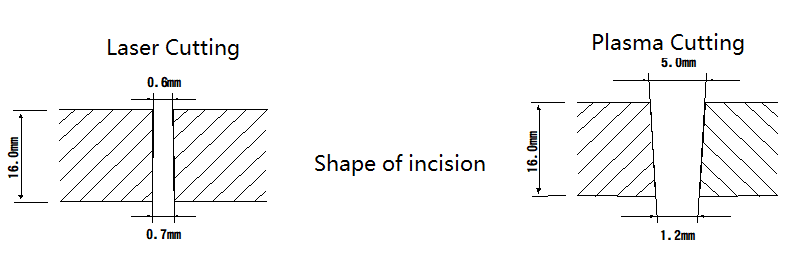
3. Service life of oxygen plasma consumables.
| Cutting method | Electrode type | Electrode processing. | Electrode life | Nozzle life |
|---|---|---|---|---|
| Oxygen plasma cutting. | Type S | Developed early | 60 minutes | 45 minutes |
| Type F | Insert the modified version | 120 minutes | 60 minutes | |
| Type LL | Insertion of special metals. | 180 minutes | 60 minutes | |
| Oxygen plasma cutting with added water | Similar to type F | Insert the modified version | 120 minutes | 150 minutes |
1 arc opening/closing cycle, 1 min endurance test longevity comparison (cut-off current value: 250A)
4 . The relationship between board thickness and cost.
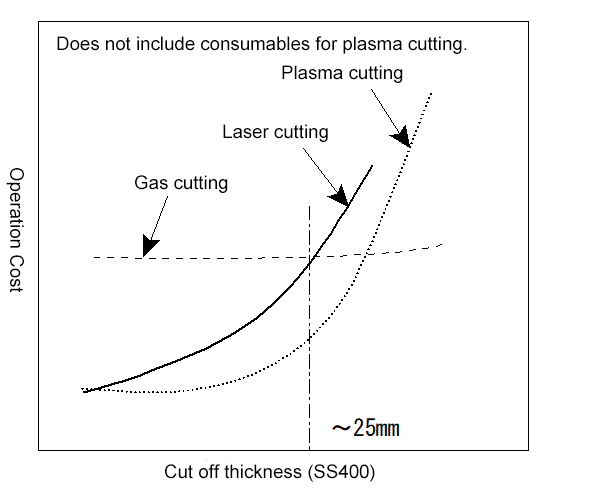
5 . The incision width and cutting accuracy of various cutting methods.
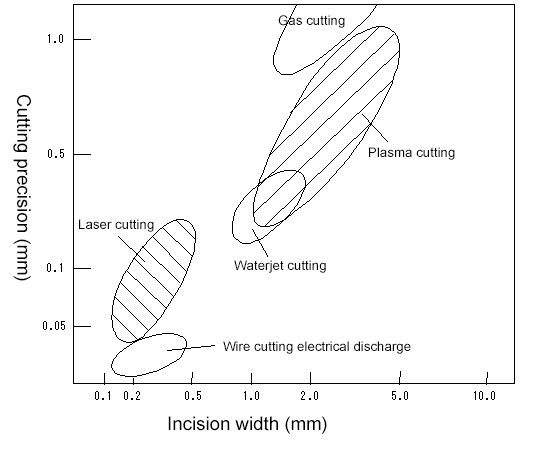
6 . Cutting conditions of various cutting methods.

Working principle of plasma and laser cutting
1. Working principle of plasma cutting machine

A processing method that uses high-temperature plasma arc heat, using oxygen or nitrogen as the working gas, to melt and vaporize the incision of a metal part.
The momentum of the high-speed plasma flow is then used to remove the molten metal, resulting in the formation of a groove.
See too:
- Plasma Cutting Machine: The Ultimate Guide
2. Working principle of laser cutting machine

The laser generated by the laser device is transmitted through a series of mirrors and focused on the surface of the part by a focusing lens, causing the hot spot on the part to melt or vaporize and forming a crack.
Simultaneously, auxiliary gas is used in the cutting process to remove slag from the crack, ultimately achieving the processing objective.
Application of Plasma and Laser Cutting
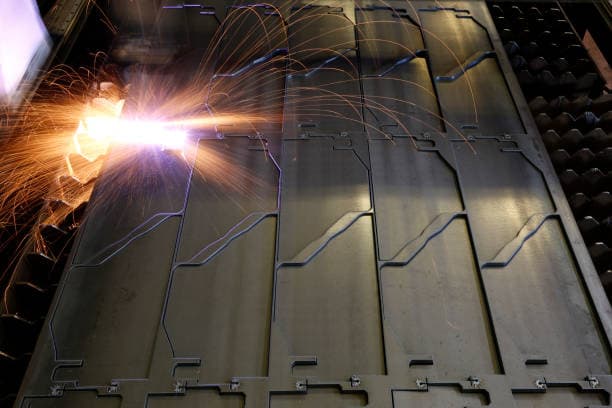
Plasma cutting is suitable for cutting all types of metal materials and is mainly used for cutting medium thickness sheets. The advantages of plasma cutting include fast cutting speed, narrow cutting slots, small heat-affected areas, minimal deformation and low operating costs.
However, a disadvantage is that it causes a 0.5-1.5 degree angle in the vertical cross-section and hardening of the incision.
Laser cutting, on the other hand, is mainly used to cut medium-thickness sheets and has a wide range of cutting materials, including metal, non-metal, ceramic, glass, etc.
Due to the laser's high direction, brightness and intensity, it has high cutting speed, high machining precision and narrow cutting seams that do not require any additional processing.
In conclusion, in terms of material cutting, laser cutting has a wider range of options than plasma cutting. For cutting thin sheets, laser cutting has a clearer advantage.
However, in terms of cost, plasma cutting is much more economical than laser cutting.
Advantages and disadvantages of plasma and laser cutting
1. Advantages and disadvantages of laser cutting
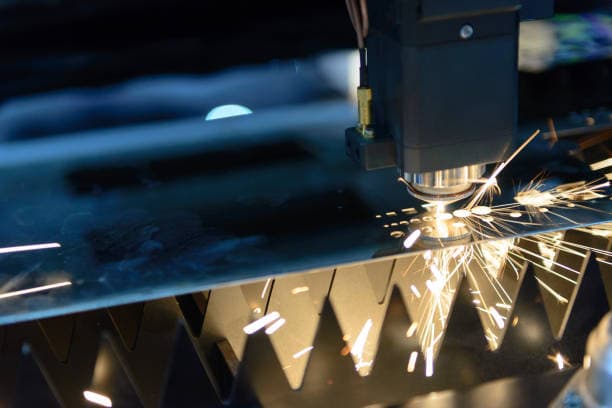
Compared with traditional cutting methods, a laser cutting machine has several notable advantages:
- Narrow cutting edges, allowing direct welding without grinding the cutting surface.
- High cutting speed: can reach 10 m/min for thin sheets, which is faster than plasma cutting.
- Excellent cutting quality: minimal deformation, low surface roughness and straight, clean edge.
- High precision: with 0.05mm positioning accuracy and 0.02mm repositioning accuracy.
- Wide range of cutting materials: in addition to metal, it can also cut wood, plastic, rubber, PVC, leather, textiles and organic glass.
However, there are also some disadvantages of laser cutting:
- High cost: both the initial investment and ongoing maintenance are more expensive.
- Currently, laser cutting is more economical for thin sheets. However, when cutting thick plates, efficiency is low and is not recommended unless quality requirements are high.
2. Advantages and disadvantages of plasma cutting
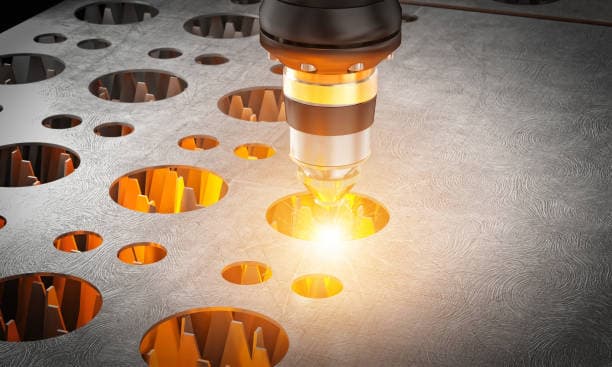
For plasma cutting, it also has its advantages and disadvantages:
Benefits :
In the process of cutting medium-thickness sheets, plasma cutting can achieve a high cutting speed, which is much higher than the speed of laser and flame cutting.
Furthermore, the initial investment in equipment is lower compared to laser cutting and the maintenance cost is also significantly lower.
Disadvantages :
Disadvantages of plasma cutting include:
- Poor perpendicularity of the cutting surface, leading to a significant oblique cutting edge on the side.
- It generates more cutting slag that needs to be removed by grinding, increasing labor costs.
- Emits harmful dust and arc light during the cutting process. However, underwater plasma cutting can mitigate this problem.
- High consumption of cutting nozzles in the long term, resulting in high costs.
Conclusion
In the information above, we provide an overview of laser cutting and plasma cutting from various perspectives.
By reading this article, we hope you now have a deeper understanding of these two sheet metal cutting methods.
The decision to use a plasma cutting machine or a laser cutting machine ultimately depends on production objectives, cost factors and accuracy requirements.
If you're still unsure, contact us and let our experts help you make a decision.

























































